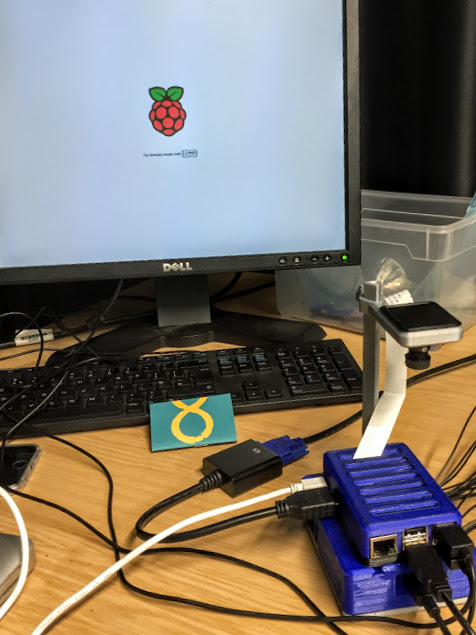(set pageLanguageSource property) |
m (Saved using "Save and continue" button in form) |
||
| Ligne 1 : | Ligne 1 : | ||
{{ {{tntn|Tuto Details}} | {{ {{tntn|Tuto Details}} | ||
| + | |Main_Picture=FlyPi_IMG_7827.jpg | ||
| + | |Licences=Attribution (CC BY) | ||
| + | |Description=FlyPi - DIY all in one biology lab that can be used for optical microscopy, diagnostics, perform state of the art methods in Neurosciences, such as Optogenetics, Calcium Imaging and Fluorescence microscopy (more details can be found in Maia Chagas, 2017). | ||
| + | |Area=Science and Biology | ||
|Type=Creation | |Type=Creation | ||
| − | |||
| − | |||
| − | |||
|Difficulty=Medium | |Difficulty=Medium | ||
| + | |Duration=28 | ||
| + | |Duration-type=hour(s) | ||
|Cost=200 | |Cost=200 | ||
|Currency=EUR (€) | |Currency=EUR (€) | ||
| − | | | + | |Tags=DIY microscope, flourescence, arduino, open source hardware, thermogenetics, raspberry Pi, optogenetics, opensource software, behavior, research, citizen science, microscopy, behavioral tracking, behavioral research, flourescent imaging, calcium imaging, LED filters, 3D printing, github repository, PCB soldering, photography, exploring |
| − | |||
| − | |||
| − | |||
|SourceLanguage=none | |SourceLanguage=none | ||
|Language=en-gb | |Language=en-gb | ||
| Ligne 16 : | Ligne 16 : | ||
}} | }} | ||
{{ {{tntn|Introduction}} | {{ {{tntn|Introduction}} | ||
| − | |Introduction=Microscopy | + | |Introduction=I started this project because I have an insatiable appetite to see how things work. Microscopy offers a lens to explore each visual frontier with its new perspectives, joy, wonder and understanding of a minuscule life usually unobserved. It is one of the most amazing experiences to be able to bring that to anyone curious of what lies beneath our immediate visual capabilities. One main constraint for curious students, researchers and educators is access to appropriate scientific tools. Likely due to high prices, set by development under a patent/scarcity methodology. One way to solve this is to DIY with the FlyPi, an all in one biology lab with powerful “off-the-shelf” electronic elements (Raspberry Pi & Arduino nano). Other than the low cost, this device allows better experimental control, customization for specific needs, and most importantly enables accessibility to get more people into exploring the micro world around them. Just putting it together is a great learning experience for everyone not immediately comfortable with electronics. Some People have even begun to join the scientific efforts and to pursue solutions to their local problems! |
}} | }} | ||
{{ {{tntn|Materials}} | {{ {{tntn|Materials}} | ||
| Ligne 31 : | Ligne 31 : | ||
Internet Connection | Internet Connection | ||
| + | |||
| + | 3D printer | ||
}} | }} | ||
{{ {{tntn|Separator}}}} | {{ {{tntn|Separator}}}} | ||
{{ {{tntn|Tuto Step}} | {{ {{tntn|Tuto Step}} | ||
| − | |Step_Title= | + | |Step_Title=Collect Materials Needed |
| − | |Step_Content= | + | |Step_Content=Electronic parts: |
| + | |||
| + | 3D print files: | ||
}} | }} | ||
{{ {{tntn|Notes}} | {{ {{tntn|Notes}} | ||
Version du 28 juin 2018 à 16:07
FlyPi - DIY all in one biology lab that can be used for optical microscopy, diagnostics, perform state of the art methods in Neurosciences, such as Optogenetics, Calcium Imaging and Fluorescence microscopy (more details can be found in Maia Chagas, 2017).
Difficulté
Moyen
Durée
28 heure(s)
Catégories
Science & Biologie
Coût
200 EUR (€)
Introduction
I started this project because I have an insatiable appetite to see how things work. Microscopy offers a lens to explore each visual frontier with its new perspectives, joy, wonder and understanding of a minuscule life usually unobserved. It is one of the most amazing experiences to be able to bring that to anyone curious of what lies beneath our immediate visual capabilities. One main constraint for curious students, researchers and educators is access to appropriate scientific tools. Likely due to high prices, set by development under a patent/scarcity methodology. One way to solve this is to DIY with the FlyPi, an all in one biology lab with powerful “off-the-shelf” electronic elements (Raspberry Pi & Arduino nano). Other than the low cost, this device allows better experimental control, customization for specific needs, and most importantly enables accessibility to get more people into exploring the micro world around them. Just putting it together is a great learning experience for everyone not immediately comfortable with electronics. Some People have even begun to join the scientific efforts and to pursue solutions to their local problems!
Matériaux
Monitor
Computer mouse - USB
Keyboard - USB
3D print files (.stl)
Custom PCB (Principle Component Board parts can be found on: https://kitspace.org/boards/github.com/prometheus-science/flypi/ )
Outils
Soldering Iron
Internet Connection
3D printer
Étape 1 - Collect Materials Needed
Electronic parts:
3D print files:
Draft

 Français
Français English
English Deutsch
Deutsch Español
Español Italiano
Italiano Português
Português